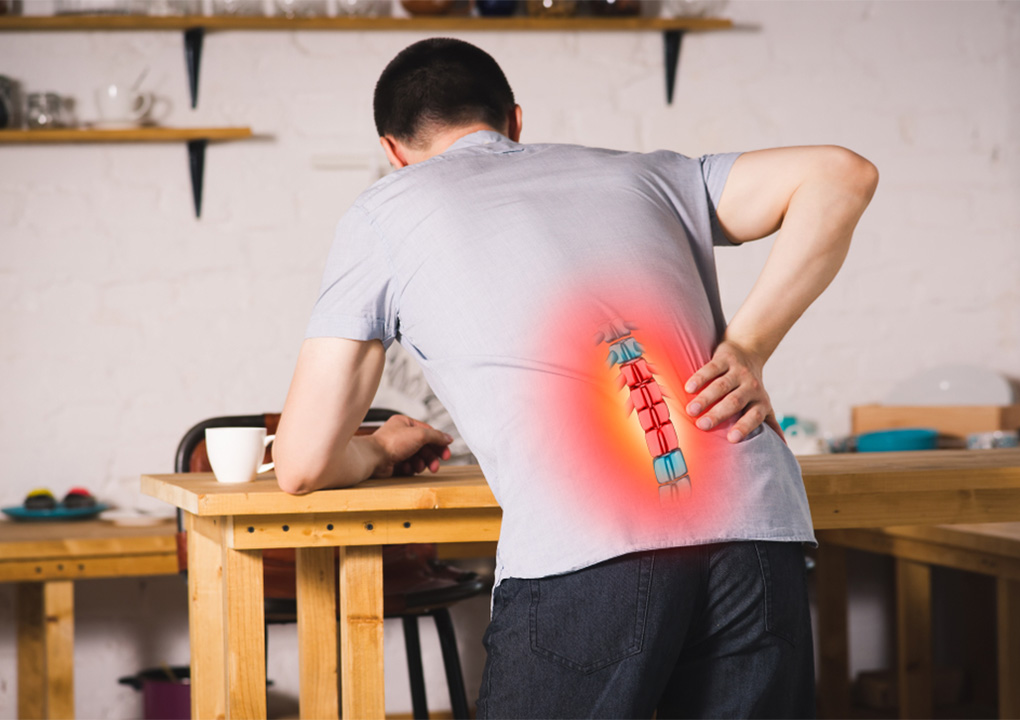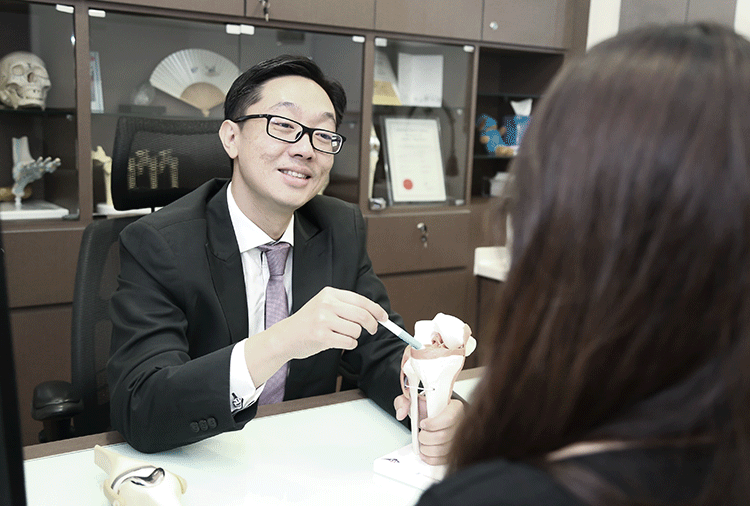What Is Slipped Disc, And Why Is Treatment Important?
What Are The Causes And Risk Factors Of Slipped Disc?
Several factors can contribute to the development of a slipped disc, including:
Age-related Changes – As we age, spinal discs gradually lose water content and elasticity, making them more prone to herniation or bulging.
Trauma or Injury – Acute trauma or injury to the spine, such as a fall, car accident, or lifting heavy objects improperly, can cause disc herniation.
Poor Posture and Body Mechanics – Prolonged sitting, bending, or lifting with poor posture can increase spine stress and the risk of disc herniation.
Genetics – Certain genetic factors may predispose individuals to develop disc herniation or degenerative changes in the spine.
Occupational Hazards – Jobs that involve repetitive bending, lifting, or twisting motions, such as construction or manual labour, may increase the risk of disc herniation.
Obesity – Excess body weight can put added pressure on the spine and increase the risk of disc herniation.
Smoking – Smoking has been associated with an increased risk of disc degeneration and herniation due to its effects on blood flow and tissue health.
What Are The Common Symptoms Of Slipped Disc?
The symptoms of a slipped disc can vary depending on the location and severity of the herniation, but common symptoms may include:
Back or Neck Pain – Dull, aching pain in the back or neck, often localised to the affected spine area.
Radiating Pain – Sharp, shooting pain that radiates down the arm (in the case of a cervical disc herniation) or leg (in the case of a lumbar disc herniation), following the path of the affected nerve.
Numbness or Tingling – Sensations of numbness, tingling, or pins-and-needles in the arms, hands, legs, or feet, indicating nerve involvement.
Muscle Weakness – Weakness or difficulty moving the affected limbs or muscles, especially with activities such as lifting or gripping objects.
Loss of Reflexes – Diminished or absent reflexes in the affected limbs, particularly in cases where nerve compression is severe.
Difficulty Walking or Standing – Pain or difficulty walking, standing, or maintaining balance due to nerve compression or muscle weakness.
How Is Slipped Disc Diagnosed?
Clinical Examination
Medical History – The doctor will review your medical history, including symptoms, onset of pain, any previous injuries or surgeries involving the spine, and any underlying medical conditions.
Physical Examination – A thorough physical examination of the spine and surrounding areas will be conducted. This may involve:
- Inspection of posture, alignment, and any visible abnormalities in the spine
- Palpation
- Range of Motion (ROM) Assessment
- Neurological Examination
Provocative Tests – Special manoeuvres or tests may be performed to reproduce symptoms, such as pain or numbness radiating down the arms or legs, and to assess for specific patterns of discomfort or neurological deficits indicative of a slipped disc.
Diagnostic Tests
- MRI (Magnetic Resonance Imaging)
- CT (Computed Tomography) Scan
- X-rays
- Electromyography (EMG) and Nerve Conduction Studies (NCS)
What Are The Slipped Disc Treatment Options?
Rest
Pain Management
Physical Therapy
Hot and Cold Therapy
Medications
Nonsteroidal Anti-Inflammatory Drugs (NSAIDs) – Over-the-counter or prescription NSAIDs such as ibuprofen or naproxen may help reduce pain and inflammation associated with a slipped disc.
Muscle Relaxants – Prescription muscle relaxants may help alleviate muscle spasms and reduce pain associated with a slipped disc.
Epidural Steroid Injections
Injections of corticosteroids into the epidural space around the affected spinal nerve may be recommended to reduce inflammation and alleviate pain associated with a slipped disc. Epidural steroid injections are typically used for short-term pain relief and may be repeated periodically if needed.
Manual Therapy
Chiropractic manipulation or osteopathic manipulation may be used to help reduce pain, improve spinal alignment, and alleviate symptoms associated with a slipped disc.
Traction Therapy
Traction therapy involves gently stretching the spine to help decompress the affected spinal discs and relieve pressure on the nerves. Traction therapy may be performed manually by a therapist or using mechanical devices.
Surgical Intervention
Surgical intervention may be considered for severe or persistent symptoms that do not respond to conservative treatments. Surgical options for a slipped disc may include:
- Discectomy – Removal of the herniated portion of the disc to relieve pressure on the spinal nerves.
- Laminectomy – Removal of a portion of the vertebra’s lamina (bony arch) to create more space for the spinal nerves.
- Spinal Fusion – Fusion of adjacent vertebrae to stabilise the spine and prevent further disc herniation.
Recovery And Prevention Strategies For Slipped Disc
For Recovery:
- Resting the spine and avoiding activities that exacerbate symptoms can help reduce pain and inflammation associated with a slipped disc. However, balancing rest with gentle movement is essential to prevent stiffness and muscle weakness.
- Applying ice packs to the affected area can help reduce inflammation and numb pain. Heat therapy, such as a heating pad or warm compress, can help relax muscles and improve blood flow to the injured area. Alternate between ice and heat therapy for 15-20 minutes daily.
- Over-the-counter pain relievers, such as acetaminophen or nonsteroidal anti-inflammatory drugs (NSAIDs), can help alleviate pain and reduce inflammation associated with a slipped disc. Sometimes, prescription medications or muscle relaxants may be necessary for pain management. A physical therapist can design a customised rehabilitation program to strengthen the muscles surrounding the spine, improve flexibility, and restore normal function. Treatment may include exercises to improve posture, core stabilisation, spinal alignment, and ultrasound or electrical stimulation modalities.
- Hands-on techniques such as spinal manipulation, mobilisation, or massage therapy can help reduce pain, improve spinal alignment, and alleviate pressure on the affected disc. Seek treatment from a qualified healthcare professional trained in manual therapy techniques, such as chiropractors or physical therapists.
- In severe or persistent pain cases, corticosteroid injections may be administered directly into the affected spine area to reduce inflammation and alleviate symptoms. These injections are typically performed under guidance from a healthcare professional, such as an interventional pain specialist.
- In severe cases where conservative treatments fail to provide relief or if neurological symptoms such as weakness or loss of bladder or bowel control occur, surgical intervention may be necessary to decompress the affected nerve roots or stabilise the spine. Surgical options may include discectomy, laminectomy, or spinal fusion.
For Prevention:
- Use proper lifting techniques to reduce strain on the spine and prevent injuries such as slipped discs. Bend your knees, keep your back straight, and lift with your legs rather than your back. Avoid twisting while lifting heavy objects.
- Practice good posture habits, such as sitting and standing up straight with your shoulders back and your spine aligned. Avoid slouching or hunching over, particularly when sitting for extended periods.
- Regular physical activity strengthens the muscles surrounding the spine, improves flexibility, and maintains a healthy weight. Focus on exercises that target the core muscles, such as abdominal and back exercises, to provide stability and support to the spine.
- Incorporate exercises that target the core muscles, including the abdominals, obliques, and lower back muscles, into your fitness routine. Strong core muscles help support the spine and reduce the risk of injuries such as slipped discs.
- Incorporate stretching exercises into your daily routine to improve flexibility and range of motion in the spine and surrounding muscles. Focus on stretches that target the hamstrings, hip flexors, and back muscles.
- Maintain a healthy lifestyle by eating a balanced diet, staying hydrated, getting enough sleep, and managing stress. These factors can contribute to overall spine health and reduce the risk of injuries.
- Pay attention to any signs of discomfort, pain, or stiffness in the spine, and avoid activities or movements that exacerbate symptoms. If you experience persistent pain or neurological symptoms, seek medical evaluation and treatment promptly.
By implementing these recovery and prevention strategies, you can effectively manage a slipped disc, alleviate symptoms, and reduce the risk of recurrence. Work closely with healthcare professionals, such as orthopaedic specialists, physical therapists, or chiropractors, to develop a personalised treatment and prevention plan based on individual needs and circumstances.






